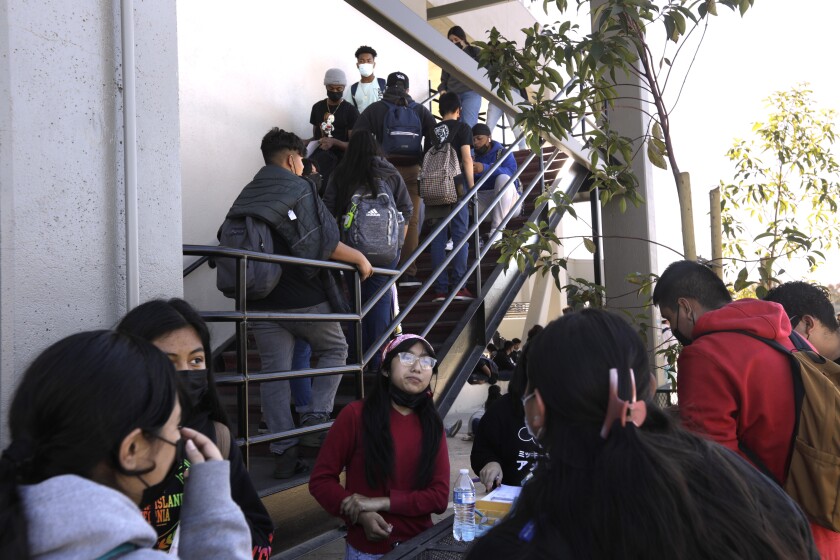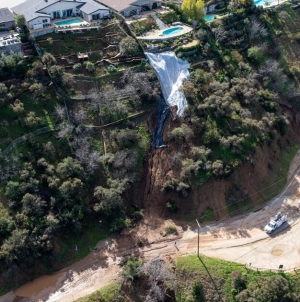-
State to pay $250 million to rebuild Lynwood High School - July 11, 2022
-
A portion of Mulholland Drive, damaged by mudslides in winter storms, reopens - May 26, 2024
-
‘Maybe You Don’t Want to Win’ - May 26, 2024
-
Donald Trump Putting Law Enforcement in Danger: Attorney - May 25, 2024
-
Avoid the waters of these 5 L.A. County beaches this holiday weekend, public health officials say - May 25, 2024
-
Bawdy Comedy ‘Anora’ Wins Palme d’Or at Cannes Film Festival - May 25, 2024
-
Map Shows Heat Wave Zone Spread Into Five New States - May 25, 2024
-
Azusa police arrest suspected slingshot-wielding vandal - May 25, 2024
-
Donald Trump Hammers Judge Ahead of Jury Instructions - May 25, 2024
-
Sometimes U.S. and U.K. Politics Seem in Lock Step. Not This Year. - May 25, 2024
State to pay $250 million to rebuild Lynwood High School
At 9:16 a.m. on Tuesday, June 16, 2020, 8 tons of concrete and metal roofing came crashing down without warning onto the concourse leading into the main classroom building at Lynwood High School. But instead of early-morning classes at the campus of 1,900 students, the school was vacant because of pandemic-forced closures.
No one was injured. Two district vehicles parked under the shady concourse were destroyed.
But the major structural failure triggered safety inspections that uncovered serious defects that prompted the shutdown of the 20-year-old campus — and led the school district to conclude that its main three-story building, with 110 classrooms, was not salvageable and must be demolished.
On Friday, officials announced that the state has agreed to pay $250 million for a new classroom building and also to make other necessary repairs.
“At a time where normally our students would be on campus looking for shade on a hot summer day, the unexpected happened: Tons of concrete collapsed,” Lynwood Supt. Gudiel Crosthwaite said. “Fortunately, this happened during the pandemic and our students were not here. Our schools were closed…. But it also forced us to relocate students and it created a domino effect across our district and our community that compromised our learning environment. The construction failure of others failed our students.”
The relatively new, 43.7-acre campus, built at a cost of $101 million, had been a symbolic touchstone for the community and the school system of about 13,000 students, which is about 94% Latino and about 5% Black, with about 94% of students coming from low-income families.
In the fall of 2021, when nearly all students statewide resumed in-person schooling, those enrolled in Lynwood High were sent to a quickly refurbished middle school. Meanwhile, elementary schools were extended to sixth grade to make up for the adaptation of the middle school.
The athletic facilities at the middle school were inadequate for regulation high school sports, but students were still able to use the outdoor fields and the gym at the shuttered campus.
The relocations and structural investigation cost the district about $16.2 million.

Lynwood High School students attend classes at a refurbished middle school after a ceiling collapsed on their campus in 2020 and the building was found to be defective.
(Genaro Molina / Los Angeles Times)
The review showed that the shoddy workmanship that led to the collapse of the ceiling above the concourse was pervasive.
All the covered outdoor hallways, which circled the perimeter of each floor of the building, had the same flaws. Any section could have collapsed without warning at any time, said Manuel Jaramillo, a construction manager and architect from Del Terra Group, who was among those who investigated the site and found that the construction at the site did not conform to the state-approved plans.
Among the issues: The concourse roofing was supposed to have firm bracing every 10 feet. Instead, there was one brace for the entire 30-foot span. In addition, the unsupported sections lacked a continuous beam going across the entire span. Instead, two cantilevered beams met in the middle and were connected together without bracing at the connection point, Jaramillo said.
Wherever inspectors looked, they found more problems, school district officials said. The building could not be saved.
“The contractor that built the school — this is the first school they built and the last one they built from the information that we’ve gotten,” said Gregory Fromm, assistant superintendent of business services, who added that the contractor has long been out of business.
The district looked at various options, including pursuing litigation and an insurance claim. But officials said they learned that their insurance covered defects only 10 years out. Meanwhile, district officials said Friday that they had no recourse against the contractor. In a settlement about 20 years ago to earlier litigation, the district had agreed to accept the school as-is and pursue no future claims against the contractor, said Lynwood school board President Alfonso Morales, who was a student in the district at the time of the school’s construction.
Morales said the lack of viable options — as well as clear answers on how this happened more than 20 years ago— has been frustrating to current district leaders, who were intent on restoring the school to their community.
Even state officials who were supporters of the rebuild project were taken aback initially at how much money the district was going to need, they said Friday; $250 million was a big ask, said Assembly Speaker Anthony Rendon and state Sen. Lena Gonzalez (D-Long Beach), both of whom attended the Friday event.
But they said they became convinced that the district lacked viable options for obtaining the needed resources by going after the parties who were responsible.
“Lynwood had a huge need due to a catastrophic circumstance,” Rendon said. “I’m extremely happy that we had the opportunity to provide funding to fill that need. Any way that you look at it, the students of Lynwood schools would be the ones to suffer if the state had not stepped in.”
“My team was a little hesitant,” Gonzalez said. “They said you know we’re going to be asking for a lot of money here…. We just knew that we wanted to get it.”
“Lynwood deserves this,” she added, “to ensure that these kids actually have a space to think about the future in a different way.”
To streamline the project, the existing building will be replaced with an already approved plan for a high school structure that was erected elsewhere.
At risk — and currently being evaluated — is the adjacent performing arts center that is part of the campus. That structure includes dance and music studios, a set construction shop and a 600-seat theater that had been used as a district and community performance venue in a low-income city that lacks a similar facility elsewhere.
Denisse Ortiz, Lynwood High‘s recently graduated salutatorian, who is headed to USC, said the last two years have been difficult for all.
“I really liked the Lynwood High campus,” she said. “There’s so many facilities, so many programs, I got to be part of, particularly the biomedical program that we offer here. And we had our own labs. It really felt like you were kind of integrating into what you would see in the future.”
Instead, she resumed her in-person education at the old middle school campus, now overcrowded, that she thought she had left behind.
Rising 11th-grader Mia Young never got to experience the high school campus, between the pandemic and the building condemnation. And the construction project is likely to take about four years, reaching completion well after she graduates.
But she was pitching in Friday as part of a team from the district’s summer school culinary class, which was handing out fruit parfaits, breakfast burritos and muffins.
The tables with refreshments were steps from architectural renderings of the new classroom building.
“I’m excited to see what it will look like even though I probably won’t be here,” Mia said.
Source link































